Communications of the ACM
The Urgency of the Technological, Geopolitical, and Sustainability Races

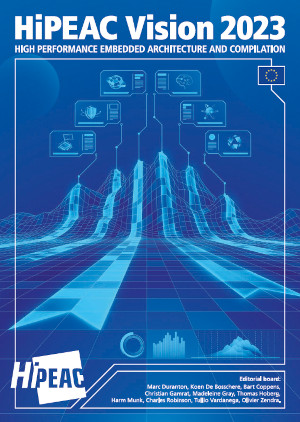
Since 2009, HiPEAC has been publishing its 'Vision' on the future of computing systems. Drawing on the expertise of the 2,000-strong European network of computing systems experts, this document acts as a strategic roadmap for the European computing community, including policy makers. It sets out the main technology trends and challenges in computing and explores what these will mean for research, business, and society in general.
The latest edition of the HiPEAC Vision was released in January 2023. The main message conveys a sense of urgency: technology is evolving faster than humans can adapt, in a context of intensifying geopolitical and environmental pressures. While previous editions of the Vision suggested that Europe still had time to decide which technology paths to take, the 2023 release suggests that now the community urgently has to take its position in six races:
- the race for the 'next Web' (the new computing paradigm that will emerge)
- the race for artificial intelligence (AI)
- the race for emerging paradigms in computation
- the race for cybersecurity
- the race for sovereignty
- the race for sustainability
Each of the above races are described and organized in sections that include an introduction and recommendations, followed by a series of articles exploring the themes in greater depth. In addition, there are three overarching recommendations:
- Break silos in various directions to gain a holistic view, which is essential for overall efficient optimizations. (Optimizing in one area may lead to unintended consequences elsewhere).
- Develop tooling for cross-disciplinary and multi-dimensional challenges.
- Develop trustable runtime orchestrators able to manage the complexity of systems.
The six races
The race for the 'next web'
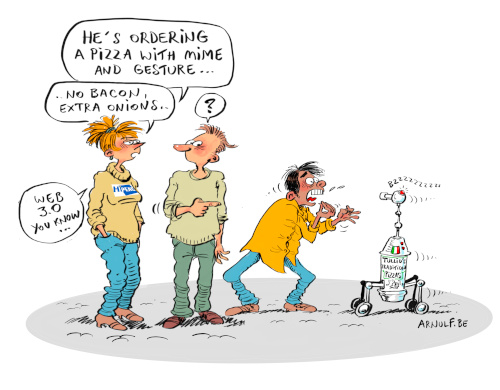
Credit: Arnout Fierens (Arnulf.be)
Ever-increasing amounts of data are being generated by interconnected machines to provide new services. The 'next web' will have to smoothly integrate the 'web of machines' with the 'web of humans'. This incarnation of the 'web' will be increasingly intertwined with the physical world, meaning that real-world constraints such as safety, real time and localization will need to be considered on a par with other non-functional requirements (such as cost, energy, etc.). Spatiality will help mark a new era where we go 'into', instead of 'on', the internet.
The key mechanism is to consider 'everything as a service' (XaaS). Applications will be dynamically built by and for users and will be composed by coordinating different services together in accordance with their individual requirements. This is a very complex task which will require smart orchestrators at the service of the user, represented in the HiPEAC Vision by 'digital genius loci'.
The race for AI
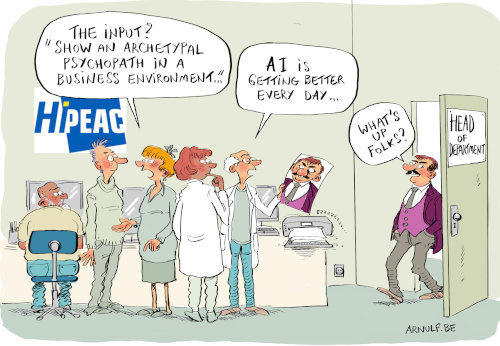
Credit: Arnout Fierens (Arnulf.be)
Large language models (LLMs) such as the GPT series are dominating the news with their ability to generate human-sounding and impressive outputs. In this arena, European actors are notable by their absence, so Europe should develop megamodels using European databases, languages and culture. European researchers should also be given access to the computational resources necessary for such models, perhaps through a pan-national infrastructure along the lines of CERN[1].
However, European rollouts of AI models should be guided by robust ethical principles and accompanied by education to help people use them and understand their pitfalls. Research should focus on developing solutions to identify and correct bias and false results by AI models, as well as reducing their energy consumption, which is currently important during their creation.
In the embedded sector, on the other hand, Europe has an advantage which it should leverage as AI becomes increasingly prevalent in embedded devices. Europe has the potential to be a leader in low-power, high-performance edge systems that use both neural networks and algorithmic approaches. HiPEAC recommends continuing research into ways of integrating deep neural networks into devices with resource constraints (such as using pruning and quantization) and developing hybrid systems.
Last, but not least, AI techniques can be used to enhance the efficiency of software engineers and system designers, as well as disrupting electronic design automation (EDA). Europe should investigate how to harness these tools to boost productivity in computer science and engineering.
The race for new hardware
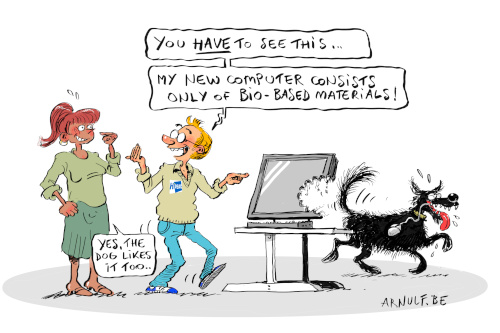
Credit: Arnout Fierens (Arnulf.be)
New paradigms such as quantum computing, neuromorphic computing, spintronics and photonic devices appear to offer faster systems to solve particular problem areas, at significantly lower energy consumption than current von-Neumann architecture-based semiconductor devices. However, as stated in previous editions of the HiPEAC Vision, new technologies will be used in conjunction with, rather than replacing, traditional CMOS platforms. Future computing devices will be hybrid systems, where each device processes a specific part of the computation, and traditional CMOS systems will act as orchestrators of domain specific accelerators using various technologies.
It should be also noted that, for example, the development of quantum computing has also renewed research in information theory, complexity theory, algorithm development and computer architecture. Europe is strong in many of these fields, but should complement its academic advantage with practical applications, environmental impacts and the development of industrial initiatives.
The race for cybersecurity
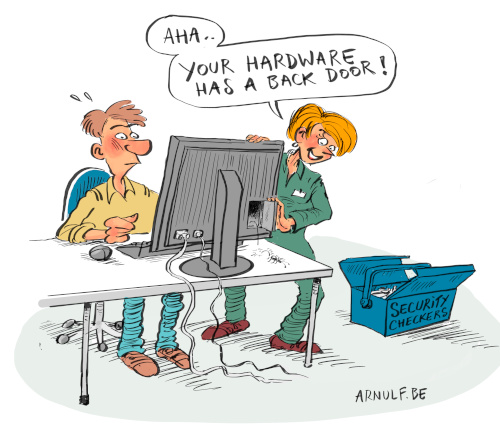
Credit: Arnout Fierens (Arnulf.be)
Cybersecurity is a highly competitive race between nations, and between defenders and attackers, with enormous stakes. The pervasiveness of computing technologies in today's world provides a broad attack surface. Attacks can be economically devastating, but they can also have tangible – even lethal – repercussions on the physical world.
Methods and tools are required to make cybersecurity and privacy first-class citizens when developing computing systems. Europe is strong in cybersecurity and has launched pioneering privacy legislation (see the General Data Protection Regulation, or GDPR). It should build on its strengths in this area, for example through increased regulation and certification to increase trust in computing systems.
The race for sovereignty
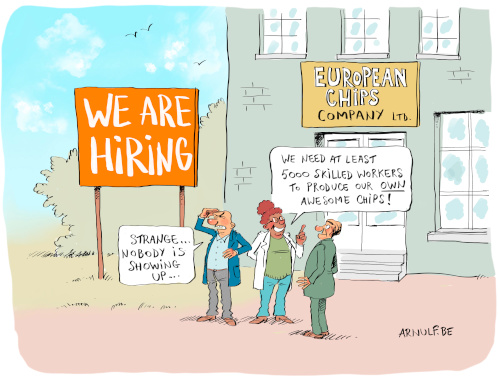
Credit: Arnout Fierens (Arnulf.be)
The past few years have shown up the weaknesses of a globalized economy, demonstrating how factors such as global health crises, natural disasters and geopolitical issues can disrupt supply chains. Given that computing is now such a widespread and ingrained part of daily life, computing technologies have become strategic assets.
The European Union has signalled its desire for greater digital sovereignty through initiatives such as the Chips Act. Sovereignty is, however, much more than building a factory in Europe: it also requires products to fill the fabs, research, innovation, an entrepreneurial ecosystem, (venture) capital, raw materials, energy, and a well-trained workforce to be successful. Europe should not only aim for hardware sovereignty, but also for software sovereignty, i.e. a software stack that is not controlled by foreign companies and agencies. Sovereignty does not necessarily mean doing everything locally; it is about having a (good) bargaining position.
Open source can be an enabler of sovereignty for Europe, by allowing the development of new technologies not dependent on closed assets and by allowing cooperation between smaller companies which form the backbone of the European economy, for example.
The race for sustainability
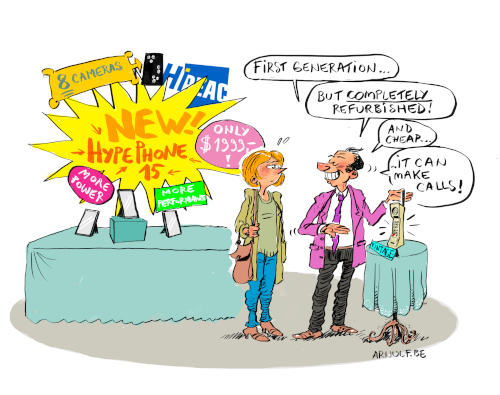
Credit: Arnout Fierens (Arnulf.be)
One major aspect of sustainability in computing is the use of raw materials: modern information technology (IT) devices require more than 60 minerals, some of which are hard to mine, scarce, or mined in unacceptable conditions. Europe should pioneer the recycling, lifecycle extension and reuse of electronic parts to help overcome this issue.
Another aspect is energy use: today, more energy is needed to produce most consumer IT devices than they will use in their entire lifetime; it may be more sustainable to continue using an old device than buying a new one. Lifecycle assessments are required to come up with sustainability solutions with real impact.
Conversely, digital technology forms an essential tool in sustainability, by enabling efficient use of resources.
Conclusion
In the face of rapid technological change and external pressures such as geopolitical tensions and global warming, the HiPEAC Vision 2023 aims to provide a clear set of priorities for the European computing research community. Across all of these is the sense of needing a holistic view and bridging communities, as optimizing in isolation may not lead to overall gains.
Further information
You can download your copy of the HiPEAC Vision here: hipeac.net/vision/2023.pdf
Alternatively, you can read individual articles here: hipeac.net/vision/#/latest/articles
HiPEAC hosts regular dissemination events and offers a selection of related resources. Contact [email protected] for further details.
[insert EU flag] The HiPEAC project has received funding from the European Union's Horizon2020 research and innovation programme under grant agreement number 871174.
Marc Duranton is a senior fellow of CEA (French Alternative Energies and Atomic Energy Commission) and a member of the Digital Systems and Integrated Circuits Division of the Research and Technology Department of CEA. Since 2009, he has been the editor in chief of the HiPEAC Vision, a roadmap produced by the HiPEAC (High Performance Embedded Architecture and Compilation) project funded by the European Union.
[1] The European Organization for Nuclear Research (CERN), is an intergovernmental organization that operates the largest particle physics laboratory in the world. This model could be replicated at European scale for AI research.
No entries found